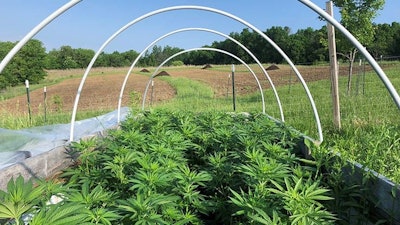
Regardless of when you started farming hemp or whether you’re growing it for fiber, grain or cannabinoids, you’ve likely considered a lot at this point in the season. From disease prevention and nutrient delivery to employee training and more, you will have even more to contemplate as you monitor your crops throughout the year and prepare for harvest.
To guide you through the growing season, Hemp Grower has compiled a wide-spanning list of actionable tips you can implement this year or make note of as you prep for next year. We’ve spoken to cannabidiol (CBD), grain and fiber farmers, as well as university researchers at the top of their fields, to bring you the some of the best information the industry has to offer in this special three-part series.
In this issue, Part I shares insights to help you prepare for planting and get your crops off to the healthiest start possible—from field selection and soil prep to pest prevention and more. (Headshots courtesy of respective subjects.)

CARL DULEY
Buffalo County Agriculture Extension Educator, University of Wisconsin-Madison
Carl Duley’s concentration for the past 30 years as an agriculture agent at UW-Madison has been on small grains, malting barley and oats; however, his foray into hemp production began in 2018 in Wisconsin’s Buffalo County with three-quarters of an acre and one dual-purpose (fiber and grain) hemp variety. While his first year wasn’t very bountiful (weeds overtook the crop, and most of it was lost), he found much more success last year with eight to nine varieties in strip trials.

JANNA BECKERMAN, Ph.D.
Professor, Botany and Plant Pathology, Purdue University
Janna Beckerman is an extension plant pathologist at Purdue University with a concentration in specialty crops (any crop in Indiana besides corn, beans or wheat). Her team has been growing hemp since 2014 and has partnered with several Indiana farmers for research through the U.S. Department of Agriculture (USDA) and the state’s hemp program. Beckerman and her team’s research in hemp has been published by the American Phytopathological Society as well as Elsevier’s Crop Protection.

RAYMOND CLOYD, Ph.D.
Professor/Extension Specialist, Kansas State University Department of Entomology
Raymond Cloyd’s expertise is based on decades of experience in the horticulture and agriculture industries and centers on pest management in greenhouses, nurseries, landscapes, turfgrass, conservatories, interiorscapes, Christmas trees, fruits and vegetables. His major clientele includes homeowners, master gardeners, and professional and commercial operators.

JEFF KOSTUIK
Director of Operations, Hemp Genetics International (HGI)/Hemp Production Services (HPS)
Jeff Kostuik spent 20 years as an agronomist and hemp contact for the government of Manitoba before joining HGI and HPS, Canada’s largest Canadian-owned bulk hemp supplier, in 2015. Kostuik’s mission is to continue the company’s decades-long pedigreed seed line and explore opportunities in CBD-rich varieties. His tips of the trade, he says, were acquired from what he calls the “school of hard knocks.”

MARTY MAHAN
Hemp Farmer/Chapter President, Midwest Hemp Council (MHC)
Marty Mahan is a fifth-generation farmer based in Rush County, Ind., where he grows corn, soybeans and hemp on approximately 200 acres. At MHC, he advocates for hemp nationwide and educates farmers and legislators on hemp farming and the industry’s challenges. Mahan has been growing hemp for research and production since the passage of the 2014 Farm Bill.

SHELBY ELLISON, Ph.D.
Assistant Faculty Associate – Industrial Hemp & Carrot, University of Wisconsin-Madison Department of Horticulture
Shelby Ellison’s work in hemp started in 2019 as she discovered a need for more training on the crop at universities. Ellison requested permission to teach a hemp science course and acquired a grower’s license last year to learn how to grow hemp herself. She has since collaborated with multiple researchers at UW-Madison on multiple small plots of hemp in Arlington, Chippewa County and Buffalo County to focus on hemp for cannabinoids, grain and fiber. She offers tips for both novice and advanced hemp farmers.

LUKE ZIGOVITS
Owner and Farm Manager, Higher Level Organics LLC
Luke Zigovits’ Wisconsin-based farm is a USDA Organic-certified, AJP Fair-certified and Sun+Earth-certified operation. With more than 20 years of cultivating and breeding as well as traditional crop agriculture experience, Zigovits’ focus in hemp is to promote regenerative practices and advance the breeding of CBD hemp to include cultivars of various chemical compositions.
_(1)_(1)_fmt.png?auto=format%2Ccompress&fit=max&q=70&w=400)
MASON WALKER
Co-Owner, CEO, East Fork Cultivars
East Fork Cultivars is a 12-acre outdoor craft hemp and adult-use cannabis operation nestled in Southern Oregon. East Fork Cultivars, which now has 13 farming employees, has been in operation for more than five years. Its USDA Organic and Sun+Earth-certified hemp products are grown, dried, cured and later processed and sold for products like CBD beverages, Rogue Ales, Gaia Herbs and more. It also produces its own hemp seed line. Walker provides pointers for CBD-rich hemp flower farmers.
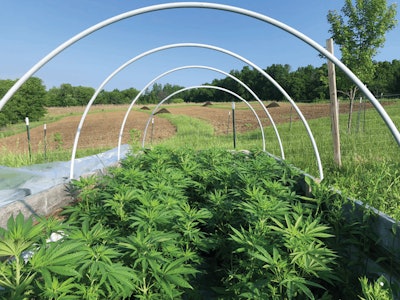
Luke Zigovits says testing your soil will help you understand your nutrient foundation.

1. Plant late, not early.
In 2018, Duley’s first year of hemp production, he planted on June 6, which he believes was about two weeks too early. He experienced some temperature swings that he believes led to weed pressure. The hemp plants started to come up right away but then “it got cold,” he says, dipping to about 50 to 60 degrees Fahrenheit. “The hemp just sat there, and the weeds exploded,” he says. In last year’s trials, however, Duley clean-tilled his soil and planted around June 11, which he says was still likely one week too early, but his crop fared much better in the warmer temps. “Err on the side of planting too late and not too early because [hemp] really likes the warm weather and sun,” he says.
2. Start with a clean field.
Duley suggests doing “anything you can do to start with a clean field, whether it’s … chemically or through tillage.” Currently, no chemical applications to kill weeds are approved for hemp crops once the seeds are planted, so starting with a weed-free bed from the get-go is essential. If growers are using chemicals, Duley says to make sure those chemicals don’t have residual properties. “Check the label before applying. Also, check the label of any pesticide that was used on previous crops. Some pesticides will have restrictions on the number of months before a different crop can be planted,” he says.
3. Follow the right crops.
Certain crops, such as soybeans and sunflowers, are very susceptible to white mold (Sclerotinia sclerotiorum), and so is hemp, Duley says. Therefore, planting a hemp crop immediately after these two crops could be a recipe for disaster if the disease persists in your soil. Duley notes, however, that if white mold remains, planting in 15- to 30-inch rows will promote airflow to the plants, which can help reduce early disease pressure.

4. Understand the nutrition and disease trade-offs of tilling.
“When I try to talk about any sort of agricultural technique, I like to point out that there’s trade-offs,” Beckerman says. “So when you don’t till, you’re conserving your soil structure and your top soil—that black gold that we covet. … You’re protecting that, but you’re also leaving in place all the pathogens that cause disease.” However, tilling’s relation to disease specifically in hemp has not been extensively studied yet.
5. Conduct a pilot study before you go full bore on hemp production.
Beckerman suggests that farmers, especially smaller farmers, start growing hemp on a small plot of land when they’re considering adding hemp to their production. It allows participation without making a large up-front investment, she says. “We’ve worked with several growers who have been slowly working their way up … whether it’s [to] a couple hundred acres or over a thousand acres,” she says.

6. Understand your major pest offenders.
Hemp is susceptible to about 20 chewing and 20 sucking insect and mite pests, Cloyd says. These include caterpillars, beetles, aphids, leafhoppers, mites and more. Some insect and mite pests that impact crops on the same farm, such as corn and soybeans, will also feed on hemp plants. One such offender is the corn earworm, which feeds on buds in the flowering stage and can cause significant damage. Some pests, such as the twospotted spider mite and aphids, are “cosmopolitan,” Cloyd says, meaning they are present in most regions of the country. Others will be more unique to certain geographic locations. In addition, it’s important to know how these insect and mite pests attack hemp plants. For instance, while the corn earworm will attack buds, leafminers will feed on leaves. “Not all the insect and mite pests I’m talking about feed on all stages of growth and development,” he says.
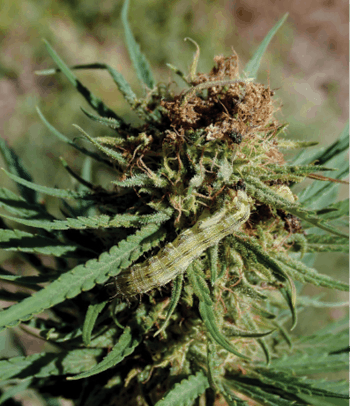
7. Prevention is key.
“You cannot allow outbreaks to occur because by that point, it’s too late,” Cloyd says. “There are materials [you can use] such as mineral oils, azadirachtin and insecticidal soaps, but remember, these are contact [applications] with short residual activity, and outdoors, they will not last very long. You need to obtain thorough coverage of all plant parts.” Cloyd notes that while farmers may never be able to completely eradicate pest problems from crops, being as preventative as possible will help reduce future problems.
8. Consider planting a ‘trap crop.’
A trap crop is one that is susceptible (or even more susceptible) to the same insect and mite pests as the main crop, Cloyd says. The trap crop lures insect and mite pests away from, and therefore protects, the main crops. Marigolds, for example, will attract mites and thrips, while eggplants are very susceptible to flea beetles. “People might want to find a reliable source regarding trap crops available and what they will lure,” Cloyd says. He suggests planting trap crops 10 feet to 30 feet away from the main crop. “You don’t want them too close because if the trap plants start dying down, then the insects with wings move onto the hemp crop,” he adds. One to two rows of trap plants may be all that is needed. “It really depends on the size,” he says. If the main crop is near a wooded area, then it would be best to place the trap plants near the wooded side of the crop. If a corn or soybean field is within a mile radius, then Cloyd recommends planting on the main crop’s windward side.
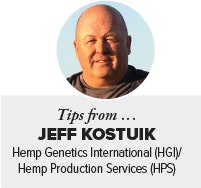
9. Select the proper field.
“A loam or clay loam soil type is most preferred for growing hemp,” Kostuik says. If soil consists predominantly of clay, or if it’s heavier, its particle sizes are too small and will cause compaction, which can prevent infiltration of water and nutrients to the root zone, he adds.
In addition, “you should probably pick a field where [a] residual herbicide was not used,” he says, because hemp is very sensitive. “Not very many herbicides are registered for hemp and for a reason: It’s very susceptible to damage from a number of different—and particularly those residual—herbicides.”
10. Seed shallow at the right temperature and moisture levels.
Kostuik recommends seeding when the soil temperature is at least 55 degrees to 60 degrees Fahrenheit. “Hopefully there’s some moisture within the top inch [of the soil] that you’re seeding,” he says.
“You obviously can’t have the soil dry right out, but you don’t want excess moisture,” he adds. Unlike soybeans, which can become dormant until conditions are favorable and start to grow, hemp is a tougher plant to get going, he says, adding that if water “ponds for a period of a day or two, hemp just does not survive.” Kostuik says that wet conditions will cause the plant to become chlorotic (turn yellow) and perish.
Kostuik recommends seeding hemp at a half-inch to three-quarters of an inch deep, which will allow the seeds to germinate and emerge from the ground quickly, he says.
“Don’t overpack the seed,” Kostuik adds. “A lot of people ask if they should roll the field before and/or after, and I discourage that. As long as you can control your seeding depth, there’s probably no need for that.”
11. Pay close attention to seed density.
“We target a seeding rate between 25 to 30 pounds of seed per acre [for grain]. On the fiber side, you might up that to 35 to 40 pounds at a minimum,” Kostuik says. While he calls for more research on the topic, this is the rate he’s found most beneficial to achieve adequate plant spacing and prevent weed pressures. This will also help the fiber crops achieve their desired “palm tree” look, as Kostuik calls it, which keeps plant canopies at the top, allowing for better air circulation and easier mechanical harvesting.
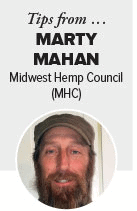
12. Find a way to seed that works for you.
“There’s more than one way to get that seed in the ground in the fiber world because it doesn’t have to be planted in rows,” Mahan says. Farmers often can use equipment they use for their other crops. “Typically, you don’t want to go any more than a half-inch deep,” he suggests. He’s used a bean drill to seed in the past, but he struggled a bit to avoid pushing the seeds too deep into the soil. On the other hand, he says, “when you use a broadcast spreader or if you use [a] Brillion seeder, those are just laying the seed on top of the ground.” After the seed is broadcast, he says, farmers can use a harrow or another piece of equipment to push the seeds down for good soil contact.
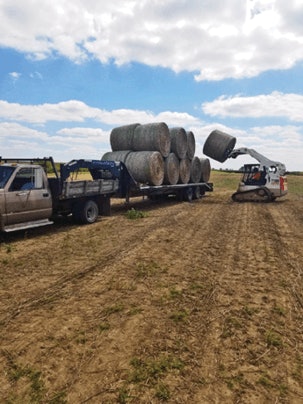
Growers who have more than an acre of production may benefit from using specialized equipment.
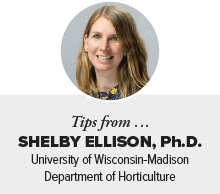
13. Understand your proximity to other hemp crops.
Hemp is a wind-pollinated crop, Ellison says, so it’s important for farmers to understand whether their neighbors’ crops could pose cross-pollination issues, especially for farmers growing for cannabinoid production and working with female plants. “I would say within a 3-mile radius of you, you want to know if anyone is growing hemp for grain or fiber production, which might be a source of pollen that could contaminate your field, as well as if there is any feral hemp, or ditch weed, near your field,” she says. “It’s going to take some communication and driving around and scouting what’s happening.” (Editor’s Note: For more about ideal buffer zones for avoiding cross-pollination issues, check out the feature “How Seeded and Seedless Hemp Crops Vary for Different End Uses” here.)
14. Find out if you can borrow equipment as you scale.
Depending on the farm’s size and what production practices will be employed, farmers may need to consider everything from a transplanter to an irrigation system. “You don’t necessarily need any specialized equipment until you get to more than 1 acre,” says Ellison. “Then you probably need to start talking to other people that you know are growing hemp near you and see what resources they have, and maybe you can share equipment.” The most important consideration for farmers is choosing equipment that is synergistic with their farming operations. For instance, the size of planting rows and total size of the plot could dictate if farmers use a mower, a rotor tiller or remove weeds by hand.
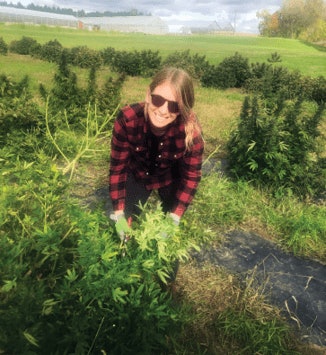
15. CBD hemp planting density differs from fiber and grain.
Ellison notes that, fortunately, the price of hemp seeds and clones is starting to fall from very high prices just a year or two ago. “It used to be more along the lines of $1 to $2 per feminized seed. Now it’s getting to be more like 50 cents to $1,” she notes. But farmers should still be mindful of their seeding density, which factors into input costs as well as mechanization. “We’ve given the recommendations before of between 1,500 and 2,000 plants per acre,” she says. She also adds that there is a “new wave of interest in converting CBD production to being more mechanized, where it would actually be planted more like a row crop,” which would allow you to direct-seed the crop very densely and machine-harvest.
Planting density also matters when considering the crop’s end product. “If you’re trying for more of a boutique, smokable flower industry similar to the marijuana space, then having individual plants that are really well-tended to and really well-spaced apart [is] going to be more of the focus,” she says. “If you’re just trying to get as much CBD off the field as possible, then it might be going to these more highly mechanized, denser planting, mechanically harvested and extracted production systems.”
16. If growing for CBD, use feminized seed.
Ellison says starting with non-feminized seed will increase not only the amount of labor needed to get rid of male plants, but also the chance of accidental pollination—which can lead to CBD content losses. “The initial investment you will put into paying a little bit more for those clones or feminized seed probably will benefit you in the long run,” she says. (Editor’s Note: The previously noted row crop production model for CBD-producing hemp uses dioecious [both male and female] seeds.)
17. Diversify your genetics, especially if just starting out.
“The nice thing with diversifying your genetics is if something doesn’t perform well, you have something else to fall back on,” Ellison says. She also notes, “If you can get things that have a slightly different maturity rate, or a slightly different photoperiod, then you can spend some of your time harvesting the thing that’s mature first, and some of your time harvesting the second crop.”

18. Test your soil.
Testing the soil will help farmers understand their foundation and tailor their production plans to fill in the gaps, Zigovits says. A soil test can determine the pH, available nutrients, heavy metals, residual pesticides and more. “Using fertilizer without wanting to do soil testing, you’re really doing yourself a disservice because you could be really high in one mineral, and you’re adding it because you think it’s going to help the hemp … grow,” he says. But in reality, he notes, adding too much of a certain mineral could create toxicity issues. When growers know what’s in their soil, they can create a unique recipe that will help deliver exactly what it is the soil is lacking and what the plants need for healthy development. “I’m not adding the same thing every year because … we’re bringing balance to the soil,” he says.
19. Focus on your micronutrients and soil biology.
Healthy hemp crops need nitrogen, phosphorous and potassium (commonly known as NPK) as their macronutrients, but they also benefit from micronutrients, so balancing a nutrient program is key for holistic plant development, Zigovits says. Instead of using a blanket application, Zigovits spot-checks areas of his plot and adds supplements when they’re needed. For instance, mycorrhizae fungi, biochar and worm castings—which help deliver beneficial microbes, carbon and other elements—balance out his nutrient regimen.
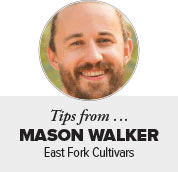
20. Ask your seed company for plant trialing data.
When it comes to selecting a seed company, “make sure they have data and, ideally, multiple years of data of how those cultivars have performed in a field,” Walker says. “That’s a really good sign of a professional breeder.” He adds that while requesting a certificate of analysis (COA) of the cultivars under consideration can be helpful, that document should also be taken with a grain of salt because it doesn’t speak to the true stability of the seed line—information determined through plant trialing, “ideally from multiple regions, multiple geographies, multiple sources,” he says. Fortunately, some breeders have started to work with university horticulture programs, he says, “and that is really valuable … because it’s more trustworthy, more valuable data from those third-party organizations that can verify a breeder’s claim … from professional trial programs.”
21. Know where your crop is going to go before it’s in the ground.
This year served as a cautionary tale for many hemp farmers who sat on hemp and had no buyers in place. “Hopefully we’ll see more savvy growing this year where people are growing specifically for a market,” he says. “It’s not like you need to have your entire crop pre-sold—that’s pretty rare, [but] at this point, I think the market is settled a little bit more and there are those [defined] categories: you’re growing just for commodity biomass; you’re growing just for extracts …; you’re working with brands that need particular … inputs; or you’re selling super high-quality trim flower.”














